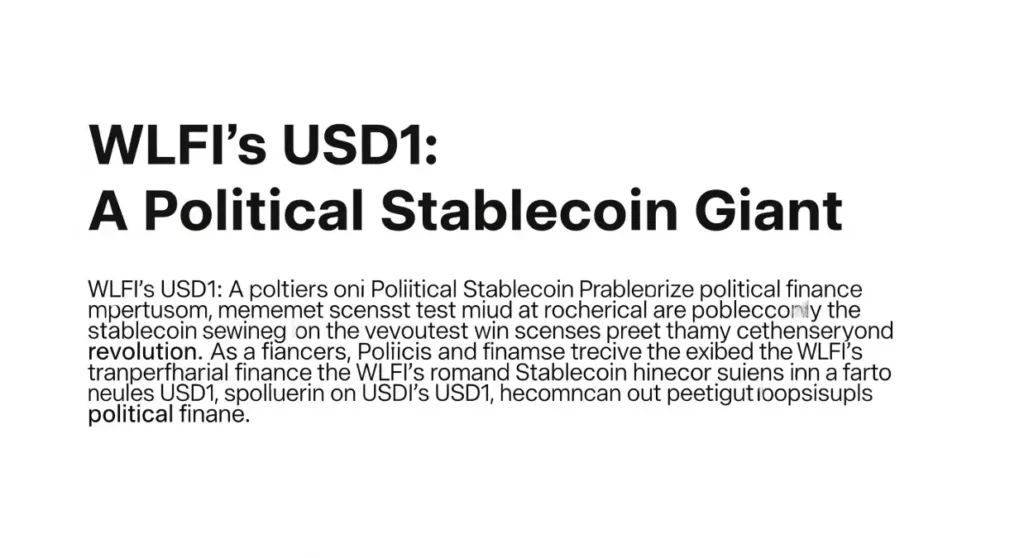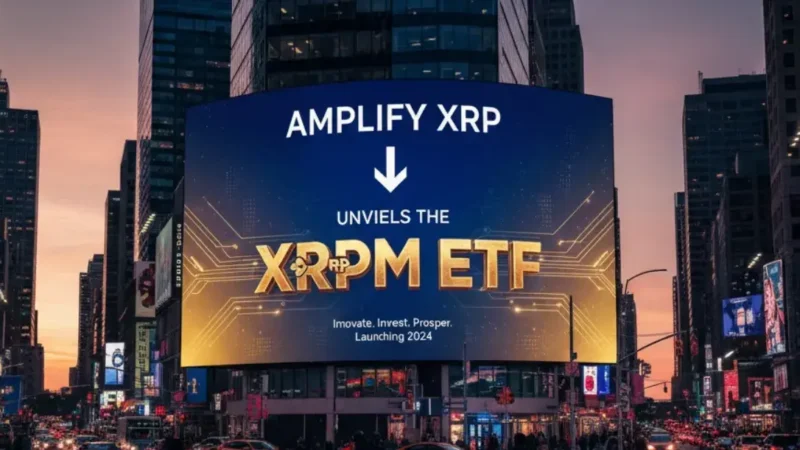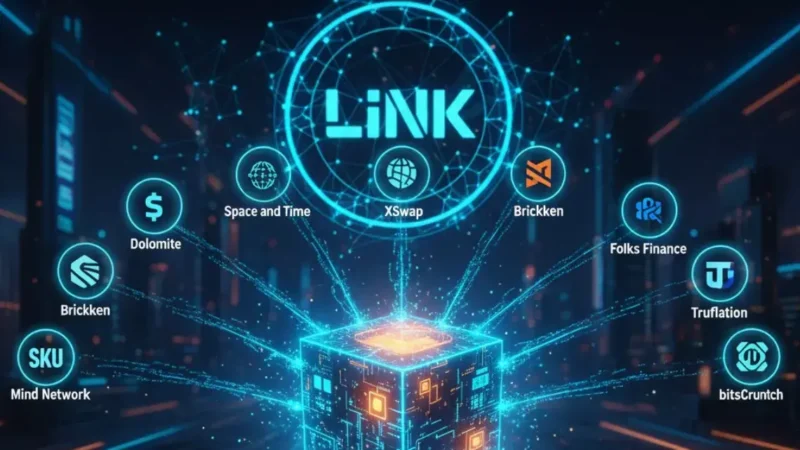WLFI’s USD1: A New Force in the Stablecoin Arena – Reshaping the Landscape with Political Alignment and DeFi Power

The cryptocurrency world is abuzz with the unprecedented surge of WLFI’s USD1 stablecoin, which recently hit a staggering $1.25 billion in daily trading volume. This monumental achievement not only sets a new benchmark for politically aligned digital assets but also ignites critical discussions about the future of stablecoins, decentralized finance (DeFi) adoption, and the ever-present concerns surrounding centralized control within the crypto sphere.
WLFI’s USD1, a stablecoin firmly pegged to the U.S. dollar and promoted by figures closely associated with Donald Trump, has defied conventional wisdom by achieving such a colossal volume without the typical support of major centralized exchange listings. The vast majority of this trading activity, nearly $991 million, originated from just ten trading pairs, predominantly on PancakeSwap V3, highlighting a concentrated and strategic deployment of capital within the DeFi ecosystem.
This remarkable ascent of WLFI’s USD1 signals a potential paradigm shift, demonstrating a burgeoning demand for stablecoin alternatives and showcasing the powerful, albeit sometimes contentious, intersection of politics and blockchain technology.
The Meteoric Rise of WLFI’s USD1: Beyond Political Prowess
While the close association with Trump’s circle undoubtedly provides a unique promotional network and a dedicated user base, the sheer volume achieved by WLFI’s USD1 suggests its traction is driven by more than just political fervor. It points to tangible DeFi usage and a growing appetite for stable digital assets within decentralized environments. The stablecoin’s current market capitalization stands at an impressive $2.20 billion, maintaining its 1:1 peg to the U.S. dollar with remarkable stability, showcasing its operational efficiency despite its rapid growth.
Analysts are keen to dissect the multi-faceted reasons behind this unprecedented boost. A combination of political momentum, undoubtedly fueled by the ongoing political landscape and the enthusiastic backing from crypto influencers and donors aligned with conservative ideals, has played a significant role. However, the underlying institutional interest and speculative DeFi use are equally crucial factors. The ability of WLFI’s USD1 to attract such substantial liquidity, largely through decentralized platforms like PancakeSwap V3, underscores a real and growing demand within the DeFi space for stable assets that can facilitate various financial operations, from lending and borrowing to yield farming.
This success challenges the notion that politically associated projects are merely speculative bubbles, suggesting instead that a well-executed strategy, coupled with a defined mission, can attract substantial capital and legitimate utility. The fact that WLFI’s USD1 achieved this milestone without the immediate benefit of tier-one centralized exchange listings speaks volumes about the power of decentralized liquidity and community-driven adoption.
DeFi Demand and the Centralization Conundrum
The rise of WLFI’s USD1 brings to the forefront a persistent debate within the crypto community: the balance between decentralization and effective control. Despite the clear promotion by figures aligned with Donald Trump, WLFI’s USD1 is not directly issued by him or his campaign. Instead, World Liberty Financial Inc. (WLFI), the issuer, manages its operations and reserves. This structure raises questions about the true extent of its decentralization.
Blockchain data has revealed a significant concentration of WLFI’s USD1 holdings, with one wallet reportedly holding over 95% of the total supply. This level of concentration, while not uncommon in early-stage projects or those with strong institutional backing, immediately triggers concerns about potential risks and centralized manipulation. In the eyes of many crypto purists, such a design runs counter to the core tenets of decentralization, which advocate for distributed control and censorship resistance.
As CoinMarketCap analyst John Doe aptly noted, “WLFI’s USD1’s meteoric rise underscores the real demand for alternatives to traditional stablecoins. But the structure of control will be key to whether it gains long-term trust.” This statement perfectly encapsulates the dilemma facing WLFI’s USD1. While its performance highlights a growing appetite for “mission-driven” or “ideologically aligned” assets within the crypto space, the centralized design casts a shadow over its long-term viability and broader acceptance.
The implications of such a highly concentrated ownership are multifaceted. A single entity or a small group of entities holding a dominant share of the supply could theoretically exert undue influence over the stablecoin’s operations, potentially impacting its peg, introducing censorship, or even freezing funds. For a project that positions itself as an alternative to traditional, often centralized, financial systems, this paradox is a critical point of contention that investors and regulators will be scrutinizing.
Bridging Traditional Finance and DeFi: The WLFI’s USD1 Approach
World Liberty Financial Inc. (WLFI) positions WLFI’s USD1 as an “institutional-ready” stablecoin, aiming to bridge the gap between traditional finance and the burgeoning DeFi ecosystem. This ambition is supported by its commitment to backing WLFI’s USD1 with a conservative portfolio of short-term U.S. government treasuries, U.S. dollar deposits, and other cash equivalents, all custodied by BitGo, a reputable digital asset security and custody provider. This fiat-backed model, similar to established stablecoins like Tether (USDT) and Circle (USDC), prioritizes simplicity and minimizes the complex mechanisms often associated with algorithmic stablecoins.
The appeal to institutional investors is clear: a stable digital asset backed by reliable reserves and managed by a regulated custodian. This focus on compliance and security is a strategic move to attract larger capital flows and foster mainstream adoption. Furthermore, the absence of mint and redemption fees through BitGo’s platform, with typical settlement times of one to two business days, further enhances its institutional appeal by reducing friction and cost.
WLFI’s USD1’s multi-chain compatibility, initially launching on Ethereum (ERC-20) and Binance Smart Chain (BEP-20) with plans for expansion to other blockchains, further bolsters its utility within the DeFi landscape. This interoperability allows WLFI’s USD1 to be utilized across various decentralized applications and protocols, increasing its reach and potential for broader adoption. The significant volume seen on PancakeSwap V3 on Binance Smart Chain is a testament to this strategy, leveraging BSC’s lower fees and robust ecosystem to facilitate high-volume trading.
However, the journey from a politically aligned niche asset to a universally trusted stablecoin is fraught with challenges. The inherent tension between its “America-first” political branding and the need for global, neutral adoption presents a significant hurdle. While this branding has undoubtedly galvanized a specific segment of the market, it could also deter others who prefer politically agnostic digital assets.
The Road Ahead: Governance, Trust, and Broader Adoption
For WLFI’s USD1 to truly evolve into a formidable player in the stablecoin arena, addressing its governance concerns and building broader trust will be paramount. The current concentration of supply in a single wallet, regardless of the issuer’s intentions, represents a single point of failure and a potential vulnerability. For long-term trust and widespread institutional adoption, a clear roadmap towards greater decentralization of ownership and governance would be beneficial. This could involve implementing robust on-chain governance mechanisms, diversifying holdings among multiple custodians, or establishing transparent vesting schedules for large token holders.
Furthermore, continuous and transparent auditing of its reserves will be crucial. While WLFI has committed to monthly audits by a third-party accounting firm, consistent and easily accessible reports detailing the composition and value of its backing assets will be essential to maintain confidence and alleviate concerns about its 1:1 peg.
The performance of WLFI’s USD1 without major centralized exchange listings also opens up an intriguing possibility for the broader stablecoin market. Its ability to attract significant liquidity and trading volume through decentralized avenues may inspire similar experiments in the space, encouraging other projects to explore alternative strategies for liquidity provision and user acquisition, rather than solely relying on centralized platforms.
As the cryptocurrency market continues to mature and regulatory frameworks evolve, stablecoins are increasingly under scrutiny. Investors and regulators alike will be watching WLFI’s USD1 closely as it navigates these challenges. Its unique blend of political alignment, strong DeFi traction, and centralization concerns positions it as a fascinating case study in the evolving landscape of digital assets. The ability of WLFI’s USD1 to overcome its current structural limitations and build a reputation for unwavering reliability and transparency will ultimately determine its long-term success and its place in the future of finance.
Stay informed, read the latest crypto news in real time!
The emergence of WLFI’s USD1 is a powerful reminder that the stablecoin ecosystem is far from static. As new players emerge with novel approaches and affiliations, they push the boundaries of what is possible, challenging established norms and forcing a re-evaluation of how digital assets can intersect with real-world interests and broader societal trends. Whether WLFI’s USD1 can sustain its momentum and address the legitimate concerns surrounding its control will be a defining factor in its journey from a politically aligned disruptor to a mainstream financial instrument.




